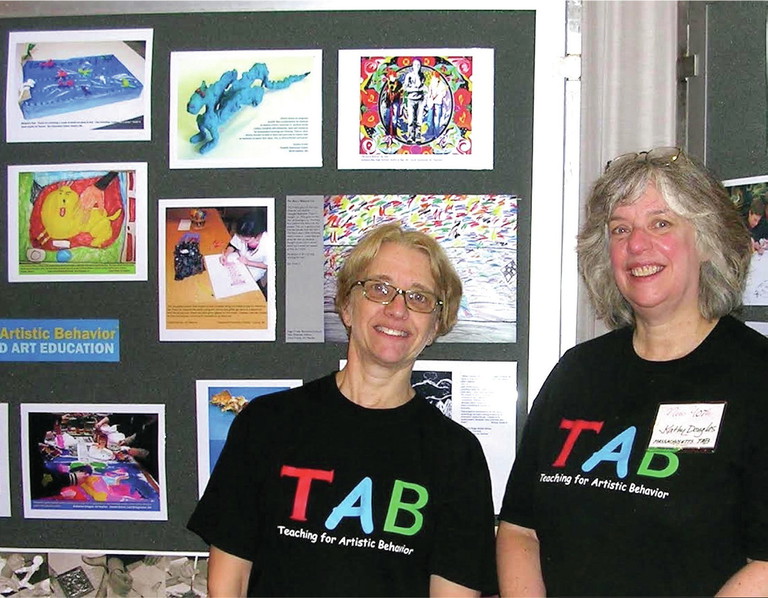ADVOCACY
The First Fifty

Diane Jaquith (left) and Katherine Douglas (right).
Abi Paytoe Gbayee
This year marks the fiftieth anniversary of Teaching for Artistic Behavior (TAB). In 1974, Katherine Douglas introduced her t wo-sentence curriculum: (1) What do artists do? (2) The child is the artist. This was the birth of TAB. Although it wouldn’t be called TAB for many years, this is the definitive origin of TAB.
Katherine Douglas
Douglas was deeply influenced by her father, a scientist, researcher, and inventor. Her family hosted many scientists at their dinner table over the years. These conversations and scientific methods would manifest in Douglas’s teaching years later as she developed a curiosity about what her students were doing as artists in her classroom.
Douglas started teaching elementary school in East Bridgewater, Massachusetts, in 1972. She had more than 950 students in lower primary grades and saw them for forty-three minutes each class. Douglas estimated that she saw students for no more than sixty hours total in the three years she taught them. With the constraints of little time and tight turnarounds between classes, Douglas wanted to support students in their artistic investigation while introducing them to new skills and concepts. This evolved into five-minute demonstrations, which would expose elementary students to more than thirty skills and techniques over the course of the school year.
John Crowe
In 1979, John Crowe joined the highschool faculty in East Bridgewater, and he and Douglas became friends. Crowe eventually took a higher education position at Bridgewater State College, where he was also responsible for teaching art to elementary students at the Burnell Laboratory School. With the bulk of his experience teaching secondary students, Crowe reached out to Douglas for support and strategies for teaching larger classes with tight schedules. Crowe found himself on “a long road to choice” (see Resource).
In 1993, Crowe wanted to connect with more art educators teaching in different or alternative ways, so he made an announcement in the Massachusetts Art Education Association (MAEA) newsletter, inviting people who felt their teaching was different or alternative to attend a meeting at the MAEA conference. At this time, Pauline Joseph joined the group. It was also around this time that Crowe became a faculty member at MassArt.
Pauline Joseph
Joseph entered the classroom as a teaching artist and developed visual menus and learning centers. She taught elementary art in Newton, Massachusetts, working under several notable administrators, including Al Hurwitz and Roland Barth. In 1995, Crowe asked Douglas and Joseph to help him teach a night course, which they named Teaching for Artistic Behavior.
Even as TAB becomes more nuanced and complex, the heart of TAB is still centered around the core tenets.
Diane Jaquith
In 1996, Jaquith was hired to teach art in New ton, where she met Joseph. Jaquith was intrigued by Joseph’s teaching methods and visited her classroom several times. Joseph encouraged Jaquith to meet Douglas at the 1997 National Art Education Association (NAEA) convention in New Orleans. Jaquith and Douglas hit it off, and Jaquith brought the third tenet of TAB into existence: The classroom is the studio. Jaquith also brought her experience working with Abigail Housen and Philip Yenawine, who had co-created Visual Thinking Strategies (VTS), which assisted TAB in becoming a movement.
The TAB Movement
Douglas, Crowe, Joseph, and Jaquith all presented about TAB regionally and at NAEA, which increased its visibility in the art education community. The Knowledge Loom website, hosted by Brown University from 1999 to 2008, was a key resource for educators looking for alternative art education approaches. The launch of the TAB Yahoo Group in 2003 has also been pointed to as one of the key factors that allowed a strong international grassroots community to form.
Over time, more educators became involved, and books were published, regional groups formed, and Facebook groups created. TAB became more than just a grassroots movement in 2007, when it was incorporated into an organization with a board of directors. This board of volunteers still exists today, running the Teaching for Artistic Behavior website and leading the TAB Institute at MassArt every summer. The community continues to grow on Mighty Net works.
TAB continues to be a pedagogy, a philosophy, a movement, and an organization. Even as TAB becomes more nuanced and complex, the heart of TAB is still centered around the core tenets: the child is the artist, the classroom is the studio, and we explore what artists do.
Abi Paytoe Gbayee is an art teacher at the University of Northern Colorado, School of Art and Design. abipaytoegbayee@gmail.com